History of Hilton Park services
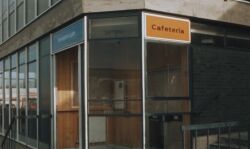
The entrance to the northbound trucker's café, in 1975.

Hilton Park services was part of the design of M6 J10 to J13, and it was finished in 1967. However, until May 1972, there was a large gap in the M6 and traffic heading towards London was told to come off a junction early and take the much faster A5. This meant Hilton Park was effectively positioned on a dead end, receiving no long distance traffic at all.
For this reason, it was agreed that the completed service area could be closed and fenced off until 1970, when the link to the M5 was opened. Cash-strapped owners Top Rank were frustrated and eager to get going. The Ministry of Transport had suggested just the petrol stations be opened, but this idea was declined by the operator.
The name Hilton Park derives from the name of the nearby stately home, who's land the facilities were built on. This was itself named after the nearby village of Hilton.
Location
See also: M6 Service Area Planning
Hilton Park has a lot to answer for. Its location is the main reason why M6 J10A only faces south, and it has also meant that a whole new dual carriageway has had to be proposed to link the M54 to the M6 Toll. For a while the service area was proposed to be closed so that junction improvements could take place either side.
Closing it would have been a problem, because the next service area is 30 miles away when heading south on the M6 and 50 miles away when heading for the M40. Considering this and just how busy this part of the M6 is, it's no surprise that between 1988 and 1997, Hilton Park was repeatedly noted for being the busiest and most profitable service station in the UK. Granada themselves claimed in March 1997 that it was actually the busiest motorway service area in Europe. The opening of other nearby service areas, like Stafford in 1999 and Norton Canes in 2004, seems to have brought Hilton Park down the league table slightly.
Its awkward location has also meant that the M54 needed its own service station - Telford.
Site Selection
Wolverhampton Express & Star, 1965
The original identified site for the service area was at Essington, where two half-sites would have been provided albeit not perfectly opposite. The site was described as "an unattractive area" and it was too small, but it was decided to be all that was available. It would have required local roads to be diverted.
The Staffordshire County Planning Committee and Local Planning Authority both objected to Essington, and the National Coal Board wanted to begin opencast operations here. Sir Owen Williams then identified Hilton Park, and presented it as the only other suitable option.
A large 24 acre area was zoned for Hilton Park, allowing for a thick wall of trees to screen the services from the surrounding area. The Ministry of Transport spent £294,000 on preparing the site (around £5million in 2025).
Original Ideas
A month after Trowell, the contract for Hilton Park was opened to tender at the end of 1963. The close contract dates proved to be a mistake as it meant rejected entrants couldn't be given feedback to improve. Forte, Blue Star and Granada were forbidden from entering as they owned the neighbouring service areas. Instead, the following bids were received:
Regent Oil
The problem with Regent's design was that it could have been placed anywhere. Even then, the Ministry, and the local planning departments they had to succumb to, preferred layouts which were sympathetic to the local environment and made the most of the landscape.
Regent proposed a very tight profit margin.
Blue Boar
Blue Boar, who already owned Watford Gap, had a financial proposal which was very poor, and its design work was very vague. This is all we know about it.
Property Investments Consolidation
This clunky title was the name of a group who owned West End restaurants in partnership with Golden Egg. They proposed building a café and restaurant on a bridge above the motorway. It would have been a very small restaurant and the car parks would have been underground.
The Ministry didn't want a bridge-restaurant at this site as the two sides were geographically very different, meaning symmetrical facilities wouldn't fit in. Bridge-facilities were falling out of favour anyway, with one civil servant citing the glare that they would cause. This, coupled with largely monochrome buildings and a poor financial offer saw the group's bid thrown out quickly.
Mecca Leisure
Of the proposals offered so far, Mecca's was the first to be taken seriously, with some decent design work and a good financial offer. Their only failing was that their restaurant had seven times as many restaurant seats as it had car parking spaces.
A month before Hilton Park, Mecca Leisure had won the contract for Trowell, which they went on to make their own with, using entirely local branding and themes. The Ministry had learned from past experience where operators had struggled to build two service area at the same time, and considering Mecca's inexperience, they did not want them to bite off more than they could chew.
Top Rank
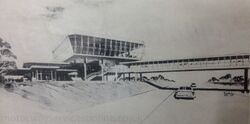
Known for their elaborate architecture, Rank didn't disappoint. Concerned that their covered footbridge would feel like a tunnel, Rank had the unique idea of putting a tea bar in the middle of it. The Ministry found the idea ridiculous: difficult to walk past, distracting to drive under and not of interest to anybody. Rank then asked if they could build a bridge which was wider at the centre than at the ends, and were again told to stick to serious proposals. They considered turning the bridge windows into motorway viewing platforms.
The tower was even more controversial. It wasn't tall enough to see over the trees which masked the good view to the west, but it was so tall it could be seen from afar in the east where there wasn't a view particularly worth talking about. They had to significantly reduce the height of it to get it approved. Indeed the whole building was described as "unnecessarily high". The original proposal included tiered seating in the tower-restaurant to offer everyone the optimum view - but not a view of anything in particular.
To add insult to injury, the petrol filling stations were placed before the car parks. Although that's a trivial design issue, it flew in the face of the last five years of service station feedback.
The north restaurant had 380 seats, south had 120. There were two more cafés, though they didn't want to lower themselves to being transport cafés. There were 370 parking spaces. It was designed by London-based architects T P Bennett & Sons, who had also designed Forton. By each building there were long covered walkways extending to the coach park. The southbound building was comparatively tiny, being only a small-L shape, with its entrance being in the middle of the bend: barely recognisable today. Rank would have been hoping to kit out the southbound restaurant with vending machines only, but following their failure at Forton, this idea was given up on.
A large grass area was provided by the northbound entrance, which was almost directly under the tower. There was also a picnic building at the far end of the southbound site, and grass around the perimeter road. Many of the grass traffic islands were larger than they are now. With the trees to the west being newly planted, there was a view across fields.
Conclusion
Site manager Donald MacPherson, 1970
Only Mecca and Rank's proposals were taken seriously. Although Top Rank's was seen as being very flexible, the offer was marginally poorer than Mecca's.
Unbelievably, it was the fact that Mecca were already building a service station which caused them not to get this contract, despite Rank already owning two of the four existing services on the M6 and despite Rank's inferior offer. Construction cost Rank around £1million (around £15million), and 250 staff were hired, including a gardening team.
Rank initially said they would have the service area open by autumn 1967, having already been delayed by an argument about sewage facilities. That October, they confirmed that they were unwilling to open it with the present traffic levels. It eventually opened on 15 May 1970 with fuel, snacks and a shop, but the restaurant and bridge remained closed, prompting an argument with Cannock Rural District Council about its business rates. The leasing fees were suspended as part of a confidential compensation offer.
Secretary of State for the Environment Peter Walker MP and Ladywood MP Dorothy Fisher made official visits to the service area on 24 May 1972, marking the completion of the motorway network in the region. Much was made of how the building's glass and concrete mixed with the grass and trees to make for a pleasant vantage.
The Restaurant
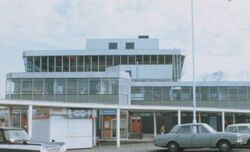
See also: Architecturally Interesting Services
Each side of Hilton Park has a distinctive tower-shape. At first both towers held restaurants; northbound offering a panoramic view enhanced by the tiered seating.
The staircase for the northbound tower is still used to access the bridge, but you cannot reach the top. On the southbound side the toilets are on the second level beneath the tower, with a second staircase being used.
In the main restaurant, a small buffet table was by the window alongside a sweet trolley. Paintings by a local artist were hung up and available for purchase.
The main restaurant didn't open until May 1972, and appears to have closed within a few years. Changes were made to the dining options in early 1971, citing continued low trade, while three French food executives redesigned the dining area in June 1975.
Both former restaurants are now closed off and stripped empty, with only a few original fittings remaining. This is a fate very similar to Rank's more famous tower at Lancaster. One incident during modifications led to a court case in 1999, following the discovery of asbestos above the ceiling tiles.
After It Opened
By just 1973, residents remarked that the parking areas were often full. Despite this, profits remained low until the 1980s. Some staff were made redundant in October 1974, with trade not expected to pick up until the new year.
The Mirror refused to rate it when they visited in August 1980. They criticised the sound and view of the motorway, the "torn seats" and "dirty floor", and called the toilets "a disgrace". Egon Ronay called the place "poor" in 1981, despite acknowledging the attractive dining area.
As finances showed signs of improving, a major refurbishment was carried out in 1982, costing £1million (around £4million in 2025). The building was painted beige in this era.
It now had a self-service restaurant branded Highway Inn, which sold a pot of coffee for 65p (around £2). There was also a fast food counter branded Highway Express, which sold hamburgers for 79p (about £3). Glasgow's Daily Record were impressed when they visited in 1984, saying the restaurants were pleasant and good value.
The motorway network's first "executive bathroom" was opened here in April 1988. It charged £2 (now worth about £5) for a shower, hair dryer, vanity basin, trouser press and hospitality kit - it was later dubbed the 'super loo'. A refurbishment saw Highway Express rebranded Just A Minute, the restaurant's branded Oasis, and the HGV driver's restaurant branded Yorkie's. A Tie Rack, florist and ice cream stall were provided on the northbound side. Egon Ronay called it "bright, modern and spacious".
The Motor Lodge was built at the back of the southbound service area in late 1988. One of the original signs, calling it a "motel", can still be found on the northbound exit to Hilton Lane, as of 2023. It was rare for any British lodge to call itself a "motel".
Refurbishment
Given its high traffic levels, Pavilion would consider Hilton Park to be worthy of major investment after they took over Rank. In 1993 the northbound side had a Burger King, and a Thorntons shop alongside the Tie Rack, as well as the 'truck driver's restaurant', along with a shop and restaurant on each side and a southbound snack bar. Blue panelling was applied around their green entry doors.
They moved the southbound forecourt to its present position, and removed the covered walkways. Doing this allowed the southbound car park to take over some of the former lorry park area, which allowed the southbound building to be massively expanded. The northbound building was expanded over some of the woodland area. Fuel was provided by both Shell and Esso at the time, and the building was painted bright green.
Pavilion were keen to promote their facilities for HGV drivers. They used the site to host several promotional events, including one where a beach (with deckchairs, ice cream and donkeys) was placed in the car park, and another where massages were offered. Five minute free therapy sessions were launched in 1994, though they were quickly axed despite being popular. Pavilion opened the UK's first motorway pharmacy here in 1995.
Shopping Era
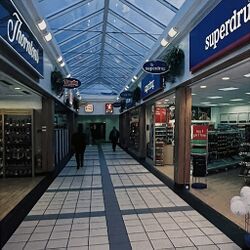
Between 1988 and 1997, media reports repeatedly claimed that Hilton Park was the busiest service area in the country, and sometimes in Europe, with Granada themselves making that claim in March 1997. This meant it had a lot of retail potential.
Pavilion had already compared it to "a shopping mall". When Granada announced that they would be creating "mini-shopping centre", this was their first. Their extension made it the first site to gain a Cyber Café, and the last to get a Trucker's Lounge. Neither of these facilities are still available, instead they are partitioned off and used as office space. The building was painted white, and the forecourt was converted to BP.
The northbound side had a corridor of shops from Thorntons, Tandy Express, Clinton Cards, Sock Shop and Superdrug. A very similar line-up was provided on the southbound side.
Following their refurbishment, Granada renamed Hilton Park to 'Birmingham North' in June 1996, arguing that more generic names would be more memorable, easier to advertise and would deter rivals from opening nearby. One columnist in The Observer complained that the name change was the work of "meddling bureaucrats", while the Burton Mail said it was done by "some anonymous minicrat". Meanwhile locals were bemused because the newly-renamed 'Birmingham North services' wasn't in Birmingham.
Granada had planned a long list of name changes that would follow Birmingham North, but following the poor reaction, they quietly changed its name back to Hilton Park in 1997.
21st Century
There were plans for a second storey to be added to the car park, creating a second storey entrance too. That didn't happen, but the Tandy Express became T2 in 2002. The northbound extensions have removed all evidence of the original entrances, both for cars and HGVs.
For a few years from 2000 the bridge between the two sides was closed to the public, following further asbestos concerns.
The multi-faith room in the southbound building was relaunched as a 'contemplation room' in 2003, where it could be used not just for prayer, but for stressed drivers to unwind.
A Costa Drive Thru was planned for the southbound service area in 2018, but this proposal wasn't pursued.
It is still a mystery as to why Hilton Park services grew to be so successful, when Frankley down the road hasn't been so lucky. Its position close to one of the UK's most notorious traffic bottlenecks will be a factor, as will its wider variety of takeaways, both of which will have contributed to its success, but that doesn't account for such a dramatic difference in fortune.
Events
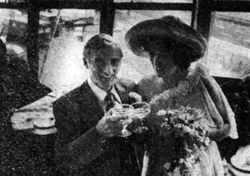
On 16 January 1975, there was a clash between supporters of Aston Villa and Manchester United. Considerable damage was caused to the service station and 130 people were arrested. Rank said they were surprised by the clash, but it would become a notorious problem for service areas.
A staff member, Beryl Rosamund, held her wedding reception at the northbound restaurant on 11 September 1975. Most of the attendees were fellow colleagues. Mrs. Rosamund would continue to work for Rank for at least another 10 years, becoming a well-known site manager. Ironically, when Pavilion took over Hilton Park, they talked about adding facilities for marriage blessings to the service area, unaware that it had almost already been done.
A controlled explosion was carried out on an unattended suitcase in November 1976. As Hilton Park was a very busy transport hub, it had to be on high alert during this difficult period for the transport industry. There had been a genuine device planted at Newport Pagnell on the M1 just a few months earlier.
On the afternoon of 21 November 1980, BBC Radio 2 broadcast live from the service area, with Sheila Tracy talking to truckers.